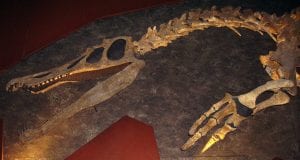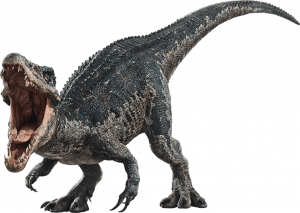When going from school to school talking about dinosaurs, it’s only natural that one of the most commonly asked questions I get is; “What is your favourite dinosaur?” Perhaps, being as I am part of the Bristol Dinosaur Project, I should say Thecodonotosaurus, but that wouldn’t be true. If I absolutely had to pick just one, my favourite dinosaur would be Baryonyx walkeri.
Baryonyx walkeri takes its name from the man who discovered it, William Walker (sadly not Barry). When wandering in the quarries of Surrey, the amateur fossil hunter stumbled across a few bone fragments quickly identified as part of a dinosaur. But one fossil above all others stood out, a 14-inch long claw, curved and sharp. Clearly, this belonged to some kind of formidable predator, a theropod, and given the fitting name, “Heavy Claw”.

As more of the skeleton was discovered, it became apparent that this was a unique theropod. Unlike Tyrannosaurus or Allosaurus, the skull of Baryonyx was not stocky, but highly elongate, more like that of a crocodile than a classic dinosaur. The teeth more like long needles than the typical thick-cone daggers of the famous carnivores.
In total, Baryonyx could measure up to 10m in length and stood about 2.5m tall at the hip. This was no small dinosaur, in fact, it is the third largest carnivorous dinosaur ever found in Britain (behind Neovenator and Megalosaurus).
The crocodilian jaw, shape of the teeth, and the large claw, all pointed to one thing, that this dinosaur was a piscivore, a fish-eater. Further evidence of this could be seen right from the first discovery, as the remains of several fish were found alongside the dinosaur skeleton.
After being initially found in the UK, Baryonyx has since been found further afield, with some specimens turning up in Portugal.
Just like its more famous relative, Spinosaurus, many palaeontologists have questioned whether Baryonyx could have been a truly aquatic dinosaur, living within rivers, and perhaps even diving to catch its prey submerged fully in the water. However, the lack of certain features, notably in the thickness of the bones (lacking pachyostosis – a characteristic that provides ballast) suggests that this was not the case. Instead, it is thought that Baryonyx would likely have waded into rivers rather than swim, in a similar way to a heron today; if that heron were 9m long with the face of a crocodile.

In 2018 Baryonyx found its way to a new level of fame by becoming one of the most recent additions to the star line-up in the Jurassic Park franchise. After settling for nothing more than a name-drop in Jurassic Park 3, Baryonyx had to wait patiently for a full 17 years to make an appearance on screen in Jurassic World: Fallen Kingdom. Whilst the name is never actually said, and it isn’t exactly the most scientifically accurate portrayal of the dinosaur (or the properties of lava), being included in the series is undoubtedly a badge of honour for any animal.
If you want to see a Baryonyx in person rather than in the movies, there isn’t any better place to go than the Natural History Museum in London, where a full reconstruction of the original skeleton can be seen prominently on the wall of the Dinosaur Gallery. Or perhaps, if you’re feeling truly adventurous, you could see another full-sized mount in the Dinosaur Museum of the Rocky Mountains.
As for me personally, I can’t say what exactly makes Baryonyx stick out in my mind. Perhaps it is simply a matter that, when growing up in the UK my mind couldn’t help but delight at the thought of a massive carnivorous dinosaur hunting in a place that might one day become my back garden. As much as we often claim to not fall for such things, all of us are really just suckers for something with big teeth and claws.
Rhys Charles is the Engagement Officer for the Earth Sciences department of the University of Bristol, and has headed the Bristol Dinosaur Project since 2016.
Article edited by Mike Hynes
References
Charig, A.J., & Milner, A.C. (1997) Baryonyx, a remarkable new theropod dinosaur. Bulletin of the Natural History Museum 53: 11 – 70
Mateus, O. et al. (2011) A new specimen of the theropod dinosaur Baryonyx from the early Cretaceous of Portugal and the taxonomic validity of Suchosaurus. Zootaxa 2827: 54 – 68
Arden, T.M.S. et al. (2018) Aquatic adaptation in the skulls of carnivorous dinosaurs (Theropoda: Spinosauridae) and the evolution of aquatic habits in spinosaurs. Cretaceous Research 93: 275 – 284

